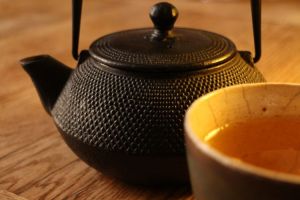Compressed tea is tea formed into a solid shape, usually after it has been taken through the traditional steps of processing. Over history these shapes have taken various forms, from flat discs (also referred to as cakes) to bricks, birds’ nests, melons, mushrooms, and hearts. Such shapes also include decorative panels meant for display instead of drinking. While compressed tea is often made of puerh there is plenty of experimentation with other types of tea.
History of Compressed Tea
The origin of compressed tea is unclear. Written documentation mentioning the consumption of compressed tea dates back to the Jin Dynasty (266-420 CE) in China. The documentation points to the increased popularity of compressed tea at the royal court and in the wealthy merchant class. Up to this point, in northern China, tea was drunk as loose leaf lightly dried in the sun or over fire, similar to what we now call green tea. Southern China, however, was another story.
The Silk Road has been in operation since 65 CE as a tea trading route from the Yunnan province. It is believed that tea was compressed as bricks and discs for such trading purposes, as loose tea takes up too much room for transportation on horseback or by foot for long distances. And since this journey took many months in the heat and humidity a kind of natural fermentation occurred resulting in a new type of tea; puerh. Given the Silk Road began long before the Jin Dynasty, it is much more likely that compressed tea was in circulation a lot earlier than appears in written documentation.
How Tea Was Compressed

In the Yunnan province, home to puerh, tea was compressed by hand until the Ming Dynasty, when clay and pottery allowed for the making of standardized molds to evenly compress the tea. The melon and mushroom shapes came as creative tea merchants sought favor from their Emperors through tribute gifts.
Today, the tea is pressed and steamed in metal models to ensure no transfer of flavor or unwanted bacteria between batches of tea. However, you can still occasionally find the hand pressed cakes.
Modern Compressed Tea
Compressed tea has made a huge comeback in China due to the focus of the Communist Party on  Chinese history and traditions, which are thought to bring strength to the country as it undergoes rapid change and modernization. This focus on history brought puerh and puerh tea cakes to the top of the tea market. Not to lose ground, manufacturers of white and oolong teas began producing their own aged cakes to compete for the attention of the newly born middle class Chinese consumer. Using much the same technology as the puerh makers, these manufacturers are charting new territories in tea production, while still using the traditional methods.
Chinese history and traditions, which are thought to bring strength to the country as it undergoes rapid change and modernization. This focus on history brought puerh and puerh tea cakes to the top of the tea market. Not to lose ground, manufacturers of white and oolong teas began producing their own aged cakes to compete for the attention of the newly born middle class Chinese consumer. Using much the same technology as the puerh makers, these manufacturers are charting new territories in tea production, while still using the traditional methods.



 It’s amazing to see how fast coronavirus has changed everything. Across the country, Americans are settling into new social isolation routines, which can be difficult and frightening, especially for those of us who enjoy long conversations with friends and family over a pot of tea. But even though times are stressful, we at Dominion Tea want to remind you to take comfort in the little things that can make it all more bearable: a healthy walk outside, a phone conversation with a loved one, or – of course – a comforting cup of your favorite tea.
It’s amazing to see how fast coronavirus has changed everything. Across the country, Americans are settling into new social isolation routines, which can be difficult and frightening, especially for those of us who enjoy long conversations with friends and family over a pot of tea. But even though times are stressful, we at Dominion Tea want to remind you to take comfort in the little things that can make it all more bearable: a healthy walk outside, a phone conversation with a loved one, or – of course – a comforting cup of your favorite tea.
 Tea Needle/Pick: These handy tools come in a variety of shapes and sizes designed to help break off sections of tea from your brick or cake without damaging its form. Picks and needles are used by sliding them horizontally between leaf layers in your tea cake, allowing you to gently pry free small measures at a time.
Tea Needle/Pick: These handy tools come in a variety of shapes and sizes designed to help break off sections of tea from your brick or cake without damaging its form. Picks and needles are used by sliding them horizontally between leaf layers in your tea cake, allowing you to gently pry free small measures at a time.



